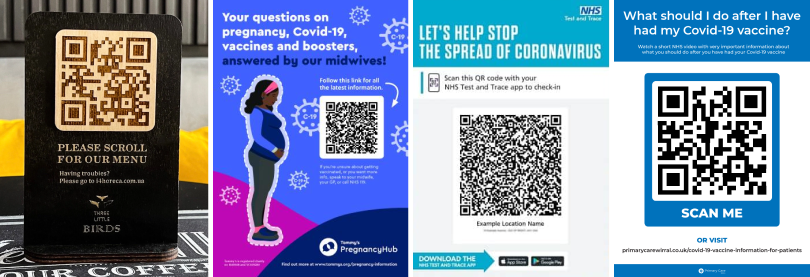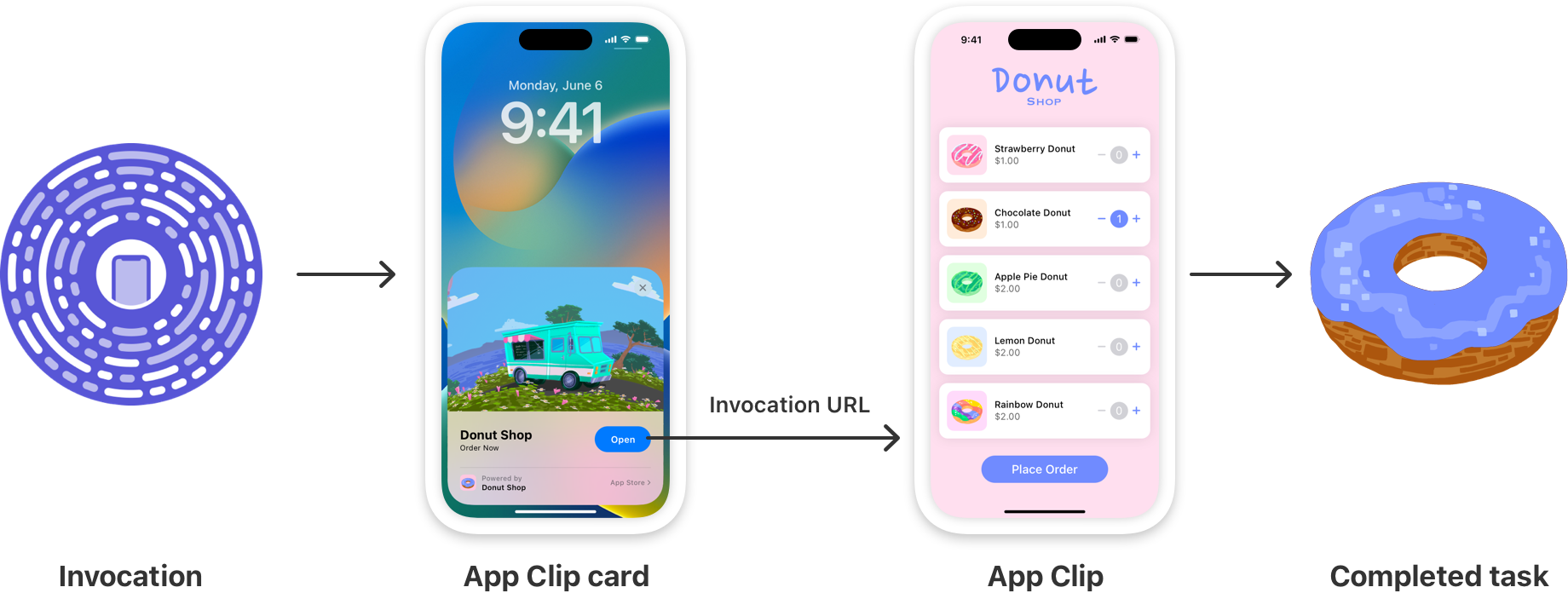In Full...
This article has a strong Apple-focus. I’m aware that similar systems exist within Android, I’m simply most familiar with Apple and generally try to stick to what I know.
Prior to 2020, the QR code seemed destined to live perpetually in the “almost made it” category of tech innovations. Despite its widespread use in industry, spotting one on a poster or product often left me wondering how it had survived the design process without someone suggesting, “Perhaps we should just make this easier to Google?”
And then, COVID happened.
The QR code emerged as an unlikely winner of the pandemic. Suddenly, these pixelated squares became portals to test entry, contact tracing, emergency information, and restaurant menus. QR codes transformed from an ugly design element slapped on the corner of a poster to a central feature of our daily lives.

This shift revealed two key strengths of QR codes:
- They provided users with effortless access to digital experiences.
- They supplied apps with contextual information about the user without requiring manual input.
In essence, QR codes enabled a user experience that designers had long envisioned: the shortest possible path between user intent and goal completion. Without realising it, we were experiencing the introduction of a type of experience that will come to define how we interact with our devices: Contextual Computing.
App Clips
In the midst of the 2020 QR code renaissance, Apple introduced App Clips. These are small, install-free portions of apps that offer specific functionality, “discoverable at the moment it’s needed.” While the timing seemed opportunistic, given the newfound appreciation for QR codes, App Clips represented a more strategic move by Apple.

App Clips address a growing issue in the current app ecosystem: people don’t like installing apps anymore. When the App Store launched in 2008, it was accompanied by the brilliant tagline “There’s An App For That.” Apple quickly realized that the ecosystem of apps would be vital to the iPhone’s success. Today, there are roughly 1.8 million apps in the store. And yet, I find myself using fewer and fewer apps.
It’s not just me. Research shows that app install rates are falling, with users tending to have fewer apps installed than they did just a couple of years ago. There are many potential reasons for this. “App Fatigue” has led users to avoid installing additional apps, viewing them as just more overhead. The barrage of push notifications, relevant or not, has fostered frustration, especially when they come from long-dormant apps. Many users are particularly annoyed by apps they’re required to install for a single event, only to delete the next day.
But perhaps the primary reason is that the process of installing an app is often convoluted for the specific tasks users are trying to accomplish, especially for one-off situations.
Take paying for parking: where once you walked up to a machine, inserted a coin, and pressed a button to print your ticket, now you must download an app, sign up, confirm your email, add your vehicle details, type in the parking location code, potentially add credit card details if Apple Pay isn’t supported, and then, finally, pay for parking. It’s hardly an improved experience.
The Data Collection Conundrum
Part of the reason apps have these convoluted processes is the insatiable desire to “own” customer data. For most companies, it’s simply not enough for the customer to use and pay for their service.
In rare cases, this extensive data collection might be justified. But for most, it’s unnecessary. The parking company, for instance, needs at most the license plate and parking location to ensure the payment is associated with the right vehicle. An email for the receipt? That’s already provided by a proper implementation of the payment system. There’s no compelling reason (beyond marketing) to require users to set up an account1.
It often feels as though many apps have forgotten that their primary goal is to deliver a service or product that users will pay for. In the case of ride-sharing or food delivery apps, it sometimes seems their main purpose is to send marketing notifications encouraging use of their services… which ironically now puts me off using them.
Apple’s Push Back
In recent years, Apple has made it abundantly clear that user privacy is a top priority. The introduction of “Sign in with Apple” in 2019 was a significant step in this direction. What initially appeared to be just another sign-in option alongside Facebook and Google logins is actually part of Apple’s broader strategy to protect user privacy.
The system uses a “Private Relay” email address by default, providing apps with a single-use email that redirects to the user’s actual address. This limits the information shared with the app provider - a data loss for the app, perhaps, but a privacy win for the user.
Apple’s requirement that Sign in with Apple must be implemented if other third-party logins are offered may frustrate developers, but it’s a boon for users. Sign in with Apple didn’t exist at the start of 2019, but was ubiquitous by year’s end.
From the effect of Ad Tracking Transparency to Mail Privacy Protection, it’s clear that Apple prioritizes protecting users over improving marketing efficacy. To some extent, it feels as though Apple is rectifying the missteps made in the early App Store years.
The Promise of App Clips
Given Apple’s reflection on past mistakes and subsequent corrective actions, it’s worth considering their motivations for creating App Clips. The limitations imposed on App Clips suggest they’re part of Apple’s broader strategy to enhance user experience while maintaining privacy:
- Fast, install-free experience
- Limited push notifications (8 hours after each launch)
- Login restricted to Sign in with Apple
- Focused on a single experience per App Clip
- Payments via Apple Pay only
- Automatic deletion after 30 days of disuse
These user-centric choices may not align with developers whose primary goal is maximizing app installs. However, they cater perfectly to developers focused on delivering the service behind the app.
Apple Intelligence, App Clips and Actions
When I wrote about Apple and AI back in February, I talked about what I’d hoped for from Apple Intelligence. One of the wishes that I had was that we had “Fewer Apps, more Actions”.
While App Clips were introduced in 2020, their full potential may be realized through integration with Apple’s AI initiatives. As Apple Intelligence gains greater contextual awareness through access to emails, messages, and location data, it can surface relevant App Clips at precisely the right moment.

I want Apple to use its knowledge of the actions available within Apps–even ones that I don’t have installed–to allow me to achieve my goals easily. For example, if I’m messaging a friend about dinner plans, an incredible experience would be being offered access to an App Clip which allows me to make a reservation right from my conversation.
To me, these seamless, contextually aware experiences represent the future of mobile computing.
For the companies that produce apps, embracing this new paradigm means focusing on creating well-designed App Clips and implementing “Actions” that can be triggered by Apple Intelligence based on user context. By shifting focus from “building an app” to “delivering a service,” developers can create more valuable, user-centric experiences that align with the evolving landscape of mobile computing.
Refocusing for the Era of Contextual Computing
When we look at Apple’s overall approach–the focus on user privacy, the increasing prominence of actions in the OS, the release of App Clips–a core message emerges. The shift towards contextual computing will require that companies refocus on their primary value proposition. The era of building an app for the sake of having an app presence is coming to an end.
Instead, businesses should ask themselves:
- What core service or product are we providing?
- How can we deliver this value to users in the most frictionless way possible?
- What are the key moments when our service is most needed, and how can we be present in those moments?
By centering on these questions, companies can move away from the mindset of “We need an app” to “We need to be available when and where our customers need us.” This shift aligns perfectly with the promise of App Clips and contextual computing.
For developers, this paradigm shift presents both challenges and opportunities:
- Rethinking User Engagement: Instead of focusing on metrics like daily active users or time spent in app, developers will need to optimize for successful task completion and user satisfaction in brief, contextual interactions.
- Modular Design: Creating effective App Clips requires a modular approach to app design, where core functionalities can stand alone and be easily surfaced in different contexts.
- Context-Aware APIs: Developers will need to become adept at leveraging the new APIs and frameworks that allow their services to be discoverable and actionable in various contexts.
- Privacy-First Development: With Apple’s strong stance on privacy, developers must find ways to deliver personalized, contextual experiences while minimizing data collection and storage.
Embracing the Future of Contextual Computing
While the journey towards truly contextual computing is just beginning, it promises to fundamentally reshape how we interact with digital services. By focusing on delivering core value in the moments that matter most, companies can position themselves to thrive in this new paradigm, creating experiences that are both more useful and less intrusive in our daily lives.
As we move into this new era of contextual computing, the rules of engagement are shifting. The focus is no longer on how many apps users install, but on delivering meaningful experiences at the right moment—when they are most relevant and needed. For businesses and developers, this transition presents both a challenge and a tremendous opportunity. Those who adapt to this new paradigm, prioritizing frictionless user interactions and respecting privacy, will be the ones who thrive.
Apple’s vision reflects a broader shift toward user-centric, privacy-first computing. By reducing the clutter of endless app installs and putting seamless functionality at the forefront, Apple is leading the way in transforming how we interact with digital services.
The future of mobile technology isn’t about building apps for every conceivable use case—it’s about intelligently delivering actions and services when and where they’re needed most.
In the end, those who embrace this shift will not only improve their user experience but will also help define the next generation of digital interactions. The age of contextual computing is here, and it’s time for companies to focus on what matters most: being present and purposeful in the lives of their users.
Footnotes
-
The counter argument to this is that the parking app stores a history (and present state) or a given vehicle’s parking which could lead to privacy risk if this was accessible only via license plate. The obvious answer to this is to associate that history/state with a given device only. We got on pretty well for many decades without needing to pull up our parking histories. ↩